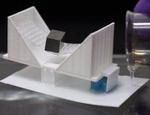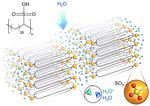Other

“Most of the time, a material’s color stems from its chemical properties. Different atoms and molecules absorb different wavelengths of light; the remaining wavelengths are the “intrinsic colors” that we perceive when they are reflected back to our eyes …

“New filter chips created by Penn engineers could enable high-quality lasers at a fraction of their current size and cost. Many emerging technologies rely on high-quality lasers. Laser-based LiDAR sensors can provide highly accurate scans of three-dimensional spaces, and as …

“When electronics need their own power sources, there are two basic options: batteries and harvesters. Batteries store energy internally, but are therefore heavy and have a limited supply. Harvesters, such as solar panels, collect energy from their environments. This gets …

“New research shows how materials can be imbued with new chemical properties using a solid phase transition method that relies on extremely fast pulses of light. Most people think of water as existing in only one of three phases: solid …

“Even without a brain or a nervous system, the Venus flytrap appears to make sophisticated decisions about when to snap shut on potential prey, as well as to open when it has accidentally caught something it can’t eat. Researchers …

“New studies identify key molecular characteristics to potentially separate rare earth metals cleanly and efficiently with light. The Science Inside smartphones and computer displays are metals known as the rare earths. Mining and purifying these metals involves waste- and energy-intense …

“Fuel cells and batteries provide electricity by generating and coaxing positively charged ions from a positive to a negative terminal which frees negatively charged electrons to power cellphones, cars, satellites, or whatever else they are connected to. A critical part …

“Current computer systems represent bits of information — the 1’s and 0’s of binary code — with electricity. Circuit elements, such as transistors, operate on these electric signals, producing outputs that are dependent on their inputs. As fast and powerful …
News Penn Collaboration Uses New Type of Graphene Sensor to Answer a Fundamental Nanotechnology Question

“Physicists at the University of Pennsylvania have invented a new type of graphene-based sensor that could one day be used as a low-cost diagnostic system able to test for biomarker molecules, which are indicative of disease states. In collaboration with …

“Researchers from the University of Pennsylvania, in collaboration with Johns Hopkins University and Goucher College, have discovered a new topological material which may enable fault-tolerant quantum computing. It is a form of computing that taps into the power of atoms …

“University of Pennsylvania researchers are now among the first to produce a single, three-atom-thick layer of a unique two-dimensional material called tungsten ditelluride. Their findings have been published in 2-D Materials. Unlike other two-dimensional materials, scientists believe tungsten ditelluride has …

“Technology tends to move toward the bigger and better, cramming more and more features into a given product. But sometimes, less is more. Robots are often called on to do the jobs that are too dirty or dangerous for humans …
